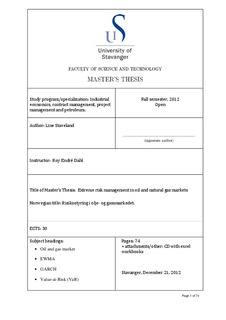| dc.description.abstract | Value at Risk (VaR) is an important calculation in risk management. It is a commonly used measure of risk in finance, and is used by corporations to estimate potential future loss. With a significance level, VaR gives the worst potential loss within a specific time period. VaR is easy to understand, and provides important information about risk.
This thesis uses data from the oil and gas industry to compare different methods of calculating the VaR. The approaches compared are the non-parametric and the parametric methods, whereas the latter is calculated based on the simple standard deviation, EWMA and GARCH (1,1). The thesis also studies the price fluctuations in the oil and gas market, which are mainly affected by changes in supply and demand.
In the oil and gas market, the minimum price is set by the last supplier needed to fulfill the demand. Production will not be profitable for that supplier if the price is less than this.
Expectations about the future have great influence on the price development. Geopolitical tensions, and other factors that could lead to reduced supply make the price increase. New discoveries, which lead to increased supply or reserves, tend to lower the price.
As this thesis will show, the period from 2002 until the summer of 2008 was a period of steady growth for oil prices, whereas the prices for natural gas also started falling in 2008 due to the financial crisis.
The normal and student-t distributions were assumed in the parametric approach, and were compared to a non-parametric approach, the historical simulation, as a benchmark.
The Kupiec-test and the Christoffersen-test were both used to test the validity of the approaches.
For all three time periods considered (250, 500, 1000 days), the non-parametric approach was without doubt the one that got accepted most by the back-tests. The VaR estimates for the 99% confidence level were dominantly better than the ones for the 95%, which the back-tests confirmed. | no_NO |
